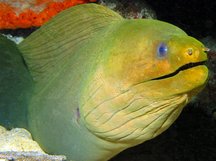

Since they are typically observed hiding in dark crevices while opening and closing their mouths in an apparently menacing gesture, it isn’t surprising that moray eels get a bad reputation. The fact that their sharp teeth face backward (causing severe damage to anyone trying to pull their hand out of a moray’s mouth) doesn’t help this reputation, and neither does the recent discovery that morays have a second set of “Alien”-like jaws that drags prey deep into their mouth and throat. The truth isn’t quite so simple. Most people know very little about these amazing animals.
The green moray (pictured above) is the most famous member of this group, but there are more than 200 species in the family Muraenidae. Green morays are not even really green (a yellow mucus deposited on a dark body creates the illusion of green skin). Snyder’s morays are less than a foot long when full grown, while giant slender morays can reach lengths of over 10 feet. Morays live in an impressive variety of habitats, including temperate and tropical seas, depths of several hundred meters, and even freshwater.
Their behaviors are as fascinating as their diversity. One species was recently observed engaging in interspecies communication (something very rarely observed in nature and not otherwise known among fishes except for cleaning stations) with groupers. Eels signal to grouper and then begin cooperatively hunting, with the eels using their unique body shape to flush prey out of crevices.
To be sure, any large fish is capable of injuring a person who isn’t careful. However, the majority of injuries occur when humans either stick their hand into a crevice without looking or attempt to hand-feed the eels. Obviously, both of these behaviors are ill-advised. There are no confirmed unprovoked attacks by a moray on a human, and I have been unable to find a confirmed report of a moray killing a human, though rumors often circulate through the SCUBA diving community. Their teeth may be fearsome, but they aren’t a threat to us. As for the mouth opening and closing behavior, it is associated not with a threat posture, but with helping to move water over their gills.
Due largely to concerns with ciguaterra poisoning, no large-scale moray eel fisheries have developed. As a consequence, no moray species are listed as Endangered by the IUCN Red List (though many species are Data Deficient or not yet evaluated).
As with other misunderstood marine life, moray eels aren’t so bad when you get to know ’em.